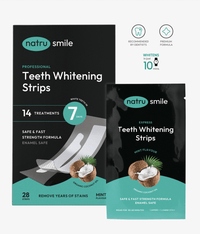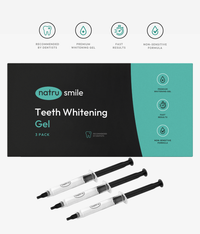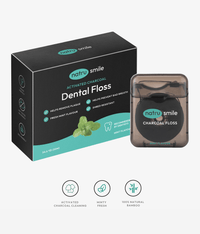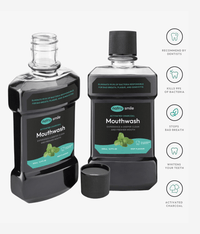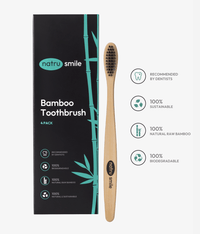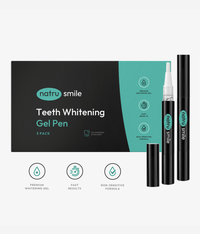
All products are certified by dental expert Dr. Greg Grillo
If you see your tooth turn grey, chances are it's because of an underlying condition such as dental fluorosis, tetracycline staining, or trauma. Fortunately, there are a variety of treatments available to help restore your tooth's natural color and improve its appearance. This article dives into different causes and treatment options for grey teeth.
Noticing your tooth turn to a dull, grey color can be unnerving. But it's actually fairly common.
Between its numerous causes, it usually isn't anything to be alarmed about.
It is, however, something that requires your immediate attention.
In this article, we'll give you everything you need to know about grey teeth, including potential causes, treatment options, and what to expect if you have them.
What Causes Grey Teeth? 8 Common Reasons
Grey teeth have numerous causes, some of which you can prevent and others that are beyond your control.
We've listed eight of the most common reasons for grey teeth below.
Dead teeth
Dead tooth—sometimes referred to as non-vital or necrotic teeth—occur when the blood supply to the tooth is cut off, causing the tooth to lose its vitality and ultimately turn grey.
The blood supply provides essential nutrients and oxygen to the dental pulp – the living tissue within the tooth. When this supply is compromised, the pulp dies, resulting in the tooth losing its natural color.
Several factors can contribute to the development of dead teeth:
- Advanced gum disease
- Trauma or injuries to the mouth
- Teeth grinding (bruxism)
- Deep cavities left untreated
- Root canal treatments
- Dental procedures
- Tetracycline staining
- Genetic factors
The amount of time it takes for a tooth to die depends on the exact cause. In the case of a dental procedure or trauma, the tooth will die relatively quickly.
If it's caused by advanced gum disease or cavities, it can take much longer for the tooth to turn grey.
Dental Restorations
Dental restorations (e.g., fillings, crowns, bridges) are one of the most common causes of grey teeth.
These treatments are typically made from either metal or composite materials, which can cause a slight discoloration over time. The extent of discoloration depends on the type and quality of material used in the restoration and how well it's been maintained.
In some cases—such as broken tooth with dental crowns or fillings—the core of the tooth is already grey due to decay.
Over time, the grey color on the inside of the tooth may become more obvious due to the surrounding dental material wearing away or the progression of the dying process within the remaining part of the tooth.
Tooth Decay
Untreated tooth decay, which impacts about one in four adults leads to grey teeth.
Dental decay occurs when bacteria in the mouth feed on sugar and produce acids that attack the tooth enamel, breaking it down and allowing bacteria to penetrate deeper into the tooth.
As the decay progresses, it can cause discoloration of the outer layer of enamel as well as discoloration of the underlying dentin—the softer, yellowish layer of tissue beneath the enamel.
Aging
Almost all individuals over 65 years (96%) have had a cavity, and the majority also have untreated tooth decay.
Apart from these factors, there are several age-related reasons why teeth may turn grey.
- Enamel wear
- Receding gums
- Staining
- Previous dental work
- Reduced saliva production
As people age, their teeth can become more susceptible to staining from foods and beverages, as well as other environmental factors.
This is because the enamel becomes thinner and more porous, allowing it to absorb more of these substances.
Dentinogenesis Imperfect
Dentinogenesis imperfecta (DI) is a rare genetic disorder that affects the development and structure of dentin, the hard tissue found beneath the tooth enamel. With an incidence rate of one in 6,000 to 8,000 people, this condition results from a mutation in the genes responsible for dentin formation, leading to weak and discolored teeth.
Individuals with dentinogenesis imperfecta often have teeth that are yellow, brown, or grey in appearance. This discoloration occurs due to structural abnormalities in the dentin layer, which compromise the integrity and strength of the teeth.
As a result, teeth are prone to fractures, wear, and sensitivity, which can significantly impact an individual's oral health and quality of life.
DI is typically diagnosed in childhood, as the primary (baby) teeth are often affected more severely than the permanent (adult) teeth.
Tooth Trauma
Injury to the tooth can lead to discoloration, as the pulp may die due to lack of blood supply.
The dead pulp will eventually turn grey or black due to necrosis (cell death), and this color may spread into the dentin layer, leading to a dark grey or brownish hue.
Most commonly, tooth trauma results from:
- Contact sports
- Accidental falls and physical trauma
- Hard-hitting bites
- Motor vehicle accidents
Some injuries necessitate root canal treatments to prevent further damage. In these cases, the grey color of the tooth may become even more pronounced after treatment and before the final restoration is placed.
Root Canal Medications
The active ingredients on root canal medications—demeclocycline hydrochloride and metronidazole—sometimes cause discoloration of the teeth.
These antibiotics are used to disinfect the root canal space and prevent infection, but they may also lead to a greyish or yellowish hue on the affected teeth.
In some cases, this effect can be reversed with whitening treatments or natural teeth whitening at home.
Tetracycline Staining
Tetracycline is commonly used to treat bacterial infections, including chlamydia, gonorrhea and Lyme disease.
Unfortunately, this oral antibiotic can potentially discolor teeth in both children and adults.
The staining can range from yellowish-brown to a deep grey, depending on the dosage and duration of the medication.
This side effect is fairly common, with a prevalence rate of 3% to 6%.
How To Fix A Grey Tooth
If one or more of your teeth turn grey, there are plenty of ways to improve your smile. The best treatment option will depend on the underlying cause of the discoloration.
1. Brushing Your Teeth With Whitening Toothpaste
If your teeth turn grey after consuming certain foods and drinks or due to age-related enamel wear, you won't have to take any drastic measures to get your teeth back to normal.
In most cases, teeth whitening toothpaste is enough to reverse the discoloration. Make sure you choose a product with the ADA Seal of Acceptance, as these are specifically designed to remove surface stains and food residues that cause discoloration.
When brushing your teeth, here are a few tips:
- Do not scrub your teeth too hard, as this can cause enamel erosion.
- Brush in circular motions, rather than back-and-forth movements.
- Spend at least two minutes brushing your teeth twice a day.
Using proper brushing techniques, you should see results within a few weeks.
2. Baking Soda
Baking soda is a natural teeth whitener, and most people have it in their houses. Research has shown that baking soda is effective at removing dental plaque, as well as surface stains—including those resulting in grey teeth.
To make a baking soda paste, mix a small amount of baking soda with a few drops of water until you get a thick, spreadable consistency. Apply the paste to your toothbrush, then brush your teeth gently in small circles. Make sure you avoid scrubbing too hard, as this can damage the enamel.
Once you're finished, rinse your mouth thoroughly with water and spit out any remaining paste.
3. At-Home Teeth Whitening Products
Plenty of teeth whitening options can be purchased online or at your nearest drug store.
Most of these products use peroxide-based bleaching agents to remove stubborn surface stains and discoloration, including grey teeth.
If you choose to whiten your teeth at home, you have several options:
Home teeth whitening costs much less than professional treatments as well, making it an attractive choice for budget-conscious individuals.
4. At-Home Bleaching Kit
Teeth whitening kits come with custom-made trays, hydrogen or carbamide peroxide bleaching gel, and other materials to help you whiten your teeth from the comfort of your own home.
Popular options include:
- LED teeth whitening systems
- Peroxide-based gel trays
- Whitening strips
You can purchase custom-made at-home bleaching kits from your dentist or you can choose an over-the-counter kit.
5. In-Office Professional Teeth Whitening
In-office teeth whitening is the most expensive option. But it is also the most effective way to get rid of grey teeth and other minor discolorations.
The treatment involves applying a powerful bleaching agent directly onto the teeth, which breaks down the molecules that cause discoloration.
Your dentist may also perform additional procedures such as micro-abrasion or laser whitening to help restore your smile.
6. Dental Veneers
Veneers are thin shells of porcelain or composite material that cover the front side of your teeth.
They can be custom-made to match your natural tooth color and shape, giving you a bright, white smile.
Some people prefer to use veneers for teeth whitening because it is a permanent solution. Unlike at-home whitening treatments, the effects of veneers can last for up to 10 years.
7. Porcelain Crowns
Porcelain crowns are another permanent solution to grey teeth, although they're more costly than veneers and other professional whitening treatments.
They are usually required as a restorative treatment to protect damaged or decayed teeth, as nobody would get a crown for aesthetic purposes alone.
For those with broken teeth, crowns can help improve their overall structure and provide a natural-looking finish. They are much thicker than temporary coverings, so they won't show any discoloration.
Want to learn more? Here are the questions our customers ask us the most.
Why Is My Tooth Turning Grey But Doesn't Hurt?
When a tooth dies, it turns grey without showing any symptoms of pain. Dental decay, trauma, or aging can all cause a tooth to die, resulting in grey discoloration that may be difficult to reverse. In these cases, the main problem is the actual health and aesthetics of the tooth, which are both still compromised.
How Can I Fix A Grey Tooth For A Toddler?
In children and toddlers, a grey tooth is not always necrotic. In most cases, is temporary. Sometimes, toddlers don't have sufficient blood flow to the teeth, resulting in discoloration. If the blood supply is damaged, further medical attention may be required. It's important to remember that toddler's teeth also fall out eventually, so even long-term discoloration should not be too much of a worry.
Why Do Teeth Turn Grey With Age?
Age is one of the most common causes of grey teeth. As we age, the enamel on our teeth begins to wear away, leaving behind a yellowish or grayish hue. This discoloration can be exacerbated by certain lifestyle choices such as smoking and drinking coffee or tea. Certain medications also impact the color of our teeth, and some of them are more commonly prescribed to older adults.
Can Grey Teeth Be Whitened?
If grey teeth are the result of dead or dying tissue, they cannot be whitened. The only possible treatments are to restore the tooth with a crown or veneer. However, if the discoloration is caused by lifestyle choices such as smoking, drinking coffee or tea, or certain medications, you may be able to whiten your teeth with natural methods, at-home kits, or professional teeth whitening.
Is It Normal For Your Teeth To Be Gray?
Grey teeth are not normal and typically indicate a problem. It is important to visit your dentist right away if you notice any discoloration, as it may be an indication of decay or other dental problems. Your dentist will be able to determine the root cause of the grey teeth and suggest a suitable treatment plan.
What Deficiency Causes Grey Teeth?
Calcium deficiency sometimes causes your teeth to turn grey. Since most people get plenty of calcium in their diets, this deficiency is rare and usually only found in those who have difficulty absorbing calcium. Other deficiencies, such as Vitamin D and phosphorus, can also cause tooth discoloration, but it won't always be grey. If you are deficient in any of these vitamins or minerals, your dentist may recommend that you take supplements to help restore the whiteness of your smile.
Can Grey Teeth Heal?
Grey teeth can sometimes heal on their own if they result from toddler's teeth not getting enough blood flow. In most cases, grey teeth are caused by dead or dying tissue or a lifestyle habit, both of which cannot reverse themselves. The only way to restore dead teeth is with a crown or veneer, which may be the best course of action if your tooth is damaged or decaying. If your teeth turn grey due to lifestyle choices or certain medications, your dentist may be able to recommend different whitening methods.
How Long Does It Take For A Gray Tooth To Turn White?
The amount of time it takes for grey teeth to turn white or become completely restored largely depends on the procedure used to treat it.
Baby teeth take three to six months to lighten their shade from grey to white.
If your grey teeth are the result of trauma or decay, they may not lighten without treatments such as a crown or veneer, which takes several weeks to complete.
If lifestyle choices cause your grey teeth, it can take several weeks for natural whitening methods to work while professional teeth whitening can provide results in just one visit.


